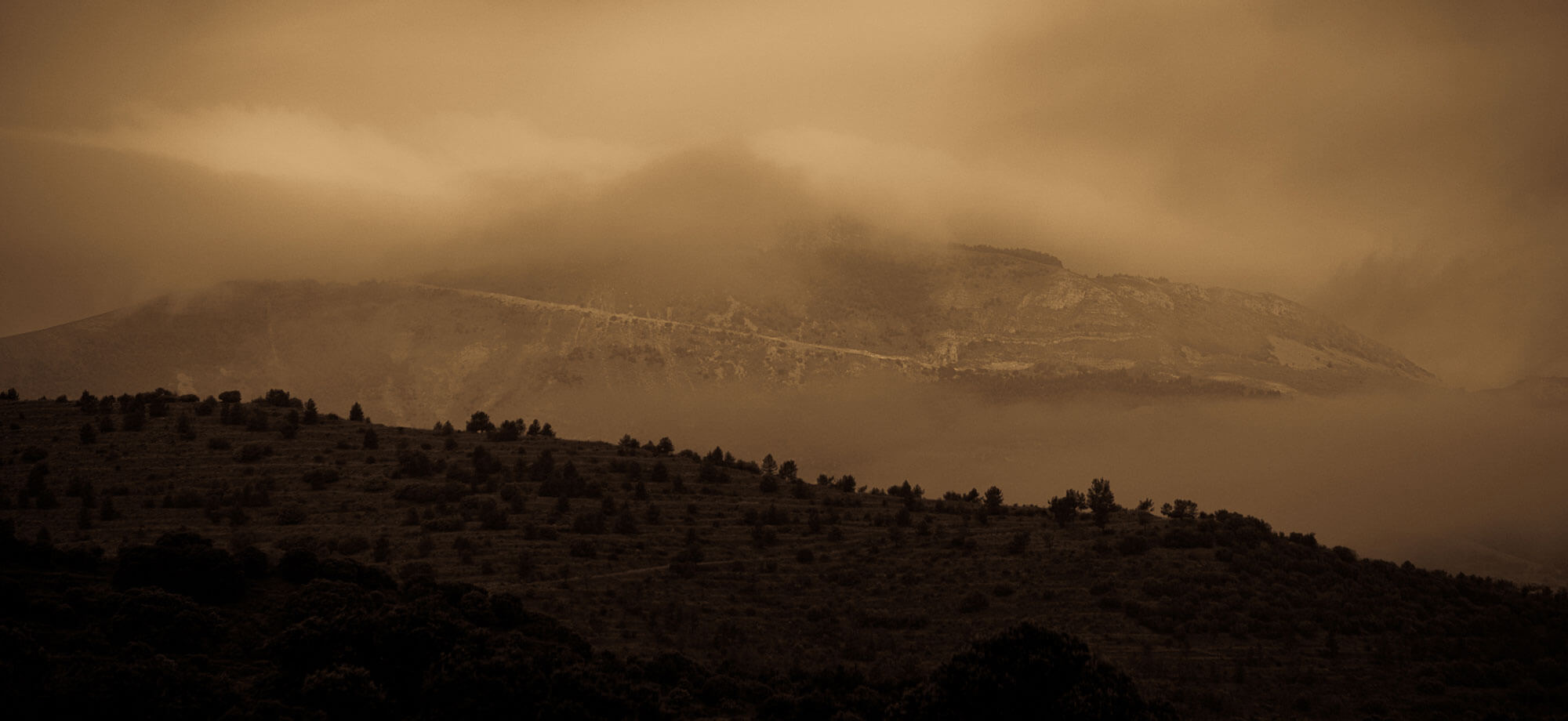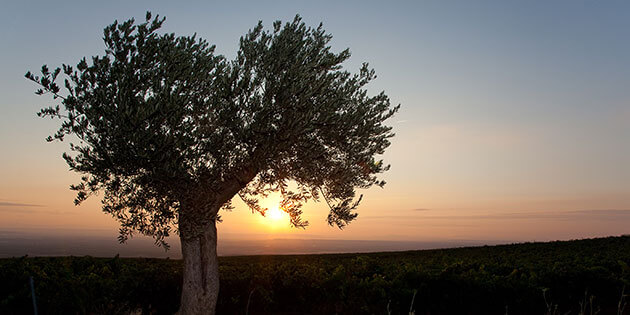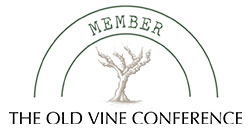The Mediterranean Rioja

Rioja Oriental and the beauty of its winter landscapes are one of the great unknown of Rioja.
The River Ebro flows down towards the Mediterranean Sea, but the vines are increasingly growing higher up on the slopes of the Sistema Ibérico mountain range. The lands of Alfaro, the sierra de la Hez, the magnificent Monte Yerga, with tunnels of underground wine cellars like the curious, historic bodega quarter in Quel, the home of Queirón. Or Aldeanueva de Ebro, with its huge varietal power; Grávalos, Tudelilla, from the strange vineyard estates in the surroundings of La Pedriza, a real sea of pebbles, to the impressive medieval wine cellar which was uncovered in the archaeological site of La Noguera. Ausejo, Alcanadre, the riverbanks of Navarra, the area around the castle of Clavijo and so many other spots in this Rioja subzone which offers all its best qualities to an essential philosophy in order to understand the wine of the DOCa Rioja in its entirety, both in its tradition, in its evolution and in the importance it has had in historic terms in the blending of the wines which have made Rioja universally famous around the world.
///CLICK HERE IF YOU WANT TO LEARN MORE
Tradition
and history
The Rioja winemaking tradition began with the presence of the Romans and the Rioja Oriental zone was one of the first places to see the cultivation of grapevines in the lands of what is now the Rioja appellation. The amphora discovered in Contrebia Leukade (Inestrillas) –dated to the 2nd century B.C– is proof of both the consumption and trade in wine which for the most part came from the regions of Campania, Etruria and Falerno in the Italian Peninsula. The end of the 1st century B.C saw the start of systematic cultivation of the modern day rioja region, with large-scale winegrowing in the Ebro Valley, Falces, Funes, as well as in Graccurris Ivlia (Calahorra), Gracurris (Alfaro) or Tritium Magallum (Tricio), as is shown by the increase in representations of vines, vine leaves and grapes in the motifs on ceramics. That means, viticulture as a way of life and of making a living and its combination with other crops, such as olives and cereals, the trilogy of the Mediterranean Diet which was already on the southern banks of the Ebro at the beginning of our era.
The History of Rioja wine was expressed down through the centuries as one of the essential vocations of a land marked by the Moorish occupation, the Reconquest, the Camino de Santiago pilgrims’ route and the boost given by the Monasteries, both San Millán de la Cogolla and Tudején and their influence on La Noguera de Tudelilla, one of the last great discoveries which reveals how these zones of the Ebro were closely in tune with wine and its culture. But it was not until 1970, with the historic regulations of the Control Board, that the subzones of Rioja were defined: Rioja Alta, Rioja Alavesa and Rioja Baja, which covered the villages of the province of Logroño situated to the east of the river Iregua and the Navarra towns and villages which have always accompanied La Rioja in its winemaking adventure.
From the late forties of the past century, cooperative bodegas began to appear in this zone, from the one in Quel (1947), via those in Aldeanueva, Arnedo, Ausejo and Alcanadre (1956) to the last one in Calahorra in 1959. With the boom in cooperativism the vineyards of the Rioja Baja began to expand: from 7,700 hectares in 1881, to 18,000 in 1960. The birth of these cooperatives was no accident and had a lot to do with the structure of property ownership and business leadership of the DOCa Rioja as a whole: the small producers gradually lost their power when faced by grape buyers from other zones in the region who increasingly imposed more and more abusive conditions, leading to the idea of joining together and create a single winery.
The history of the Rioja Oriental is the history and the drams of many growers who live for and from the vines. Many of them used the cooperatives as the springboard to create their own brands, to sketch out the new memory of an almost virgin and unknown territory, where they feel proud that over half of the grapes produced are sold to the other two Rioja subzones in order to complement their wines and make the coupage style possible.

The olive tree is one of the great riches of the biodiversity of this Rioja territory.

La Pasada.
Geography
soils and climate
The Rioja Oriental zone is defined by the river Leza and the Cameros mountains (to the east of the river Iregua), following the shores of the Ebro as far as the river Alhama, and occupies the lands between Logroño and Alfaro, including the eight Navarra municipalities on the left bank of the River Ebro. If you travel down the Ebro from west to east, you can see that from the Conchas de Haro to Logroño the course of the river meanders more or less in accordance with the topography of the land. From Logroño, the valley widens as if it was searching for light and the surfaces are stepped in terraces on either side of the river bed.
As we move further away from the river the platforms climb to higher altitudes and are much older, as is the case in the area of the Monte Yerga and particularly in the Quel peaks. The soil confers distinctive characteristics to a wine and the climate in La Rioja is the most decisive factor in determining its quality. But the importance of altitude is becoming increasingly significant with regard to climatic variations; that is, temperature and rainfall.

The poor soil of the vineyards affects the personality of the Quel wines.
In the Rioja Oriental the vineyards can be found at a range of heights which go from end to end, north to south. From the 300 metres of the plots nearest to the riverbed to over 700 metres of altitude in the case of the slopes of the Sistema Ibérico which form the Sierra de la Hez and the most easterly of all, the Sierra de Yerga.
With such a patchwork of soils, microclimates and altitudes, combined with the rich range of varieties and the different winemaking traditions of each village, the multitude of types and styles of wines proves simply amazing. Both those that we already know and the new projects that have been set in motion in recent years, as in the case of our Queirón bodega.
From the physical perspective, in the Riojan soils there are a number of key aspects such as the structure or the way in which the physical elements (clay and humus) are arranged. The soil-climate combination of the Rioja area gives exceptional conditions to the cultivation of the grapevine which allow the berry to reach the winemaking phase in ideal conditions. The colour of the soil is also very important, something determined by the atmosphere and temperature closest to it, which obviously has a key role in the ripening of the grapes. In the Rioja Oriental zone, the soils are a lighter colour than in other zones because they contain less organic matter and are therefore less fertile and have lower yields. A reddish colour denotes the presence of clay near the surface and a paler colour is due to the presence of high proportions of carbonates, especially calcium carbonate (chalk). The stoniness is another decisive feature in the vineyard soils, since the gravel content has a positive effect on the suitability of the soil for growing vines and it is very typical of soils planted with vines on terraces and banks.

Soil with stones, characteristic of the river pasts of this area.
The Riojan section of the Ebro valley has a climate character with certain continental features which can be seen in their maximum expression in the Rioja Oriental. The Rioja Alta zone is more Atlantic and the Oriental more Mediterranean, although in the case of the Queirón vines, the height of the vineyards gives the wines a very different style because they receive the Mediterranean exposure to the sun (ideal for maturation) and the freshness of the altitude, with much more extreme temperature gradients than zones lower in the valley, which results in the depth of the wines, with slower, serene ripening processes.

